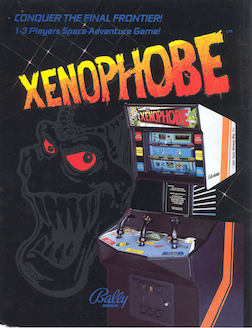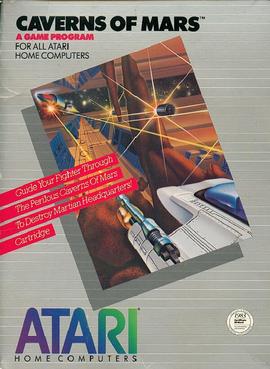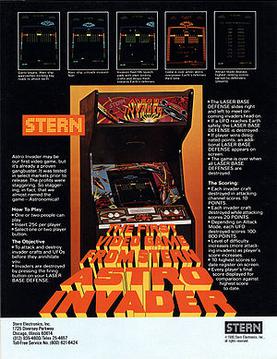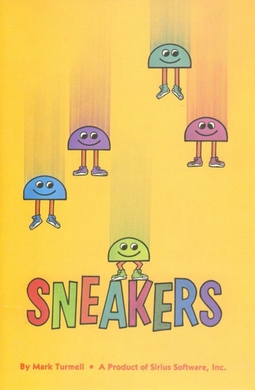
Xenophobe is a video game developed by Bally Midway and released in arcades in 1987. Starbases, moons, ships, and space cities are infested with aliens, and the players have to kill the aliens before each is completely overrun. The screen is split into three horizontally-scrolling windows, one for each of up to three players, yet all players are in the same game world.

Stargate is a horizontally scrolling shooter released as an arcade video game in 1981 by Williams Electronics. Created by Eugene Jarvis and Larry DeMar, it is a sequel to Defender which was released earlier in the year. It was the first of only three productions from Vid Kidz, an independent development house formed by Jarvis and DeMar. Some home ports of Stargate were renamed to Defender II for legal reasons.

Communist Mutants from Space is a fixed shooter video game programmed by Stephen H. Landrum for the Atari 2600 with the Starpath Supercharger cassette accessory. It was published in 1982 by Starpath. The game is similar to Galaxian, adding a variety of gameplay-changing options.

Caverns of Mars is a vertically scrolling shooter for Atari 8-bit computers. It was written by Greg Christensen, with some features later added by Richard Watts, and published by the Atari Program Exchange (APX) in 1981. Caverns of Mars became the best selling APX software of all-time and was moved into Atari, Inc.'s official product line, first on diskette, then on cartridge.
Sirius Software was a California-based publisher of video games for the Apple II, Atari 8-bit computers, Commodore 64, and VIC-20. Most games were written for the Apple II, then ported to other systems. The company was founded in 1980 by Jerry Jewell and Terry Bradley and released over 160 games before folding in 1984. Sirius also developed games for the Atari 2600 which were published in 1982 and 1983 by 20th Century Fox Video Games. Fox's failure to pay Sirius resulted in company's downfall. Nasir Gebelli wrote some of the early hits from Sirius, establishing his reputation as an Apple II game programmer.

Astro Invader, originally released in Japan as Kamikaze lit. Divine Wind, is an arcade fixed shooter developed by Konami, and the first arcade game published by Stern Electronics. Astro Invader was ported to the Emerson Arcadia 2001 in 1982.

Space Dungeon is a multidirectional shooter released as an arcade video game by Taito in 1981. Designed and programmed by Rex Battenberg, it was available both as a conversion kit and full arcade cabinet. An Atari 5200 port was published in 1983.

Crossfire is a multidirectional shooter created by Jay Sullivan for the Apple II and published by On-Line Systems in 1981. Using keyboard-based twin-stick shooter controls, the player maneuvers a ship in a grid-like maze. Versions with joystick-control use the stick for movement and switch to firing mode when the button is held down.
Nasir Gebelli is an Iranian-American programmer and video game designer usually credited in his games as simply Nasir. Gebelli wrote Apple II games for Sirius Software, created his own company Gebelli Software, and worked for Squaresoft. He became known in the early 1980s for producing fast action games for the Apple II, including 3D shooters.

Sneakers is a fixed shooter video game for the Apple II written by Mark Turmell and published by Sirius Software in 1981. A version for Atari 8-bit computers was released the same year. Sneakers was Turmell's first published game. He later was the lead designer and programmer of 1993's NBA Jam.

The Tail of Beta Lyrae is a horizontally scrolling shooter written by Philip Price for Atari 8-bit computers and published in 1983 by Datamost. The music is by Gary Gilbertson. Price and Gilbertson later collaborated on the Alternate Reality games.

Starship 1 is a first-person shooter space combat game developed and manufactured for arcades in 1977 by Atari, Inc. The game, which takes great inspiration from the then very popular television series Star Trek, contains the first known Easter egg in any arcade game. The arcade game was distributed in Japan by Namco in 1978, and it was ported to the Atari 2600 as Star Ship.

Gorgon is a clone of the arcade game Defender, a horizontally-scrolling shooter, for the Apple II. It was programmed by Nasir Gebelli and published by Sirius Software in June 1981.

Bandits is a 1982 fixed shooter written by Tony and Benny Ngo for the Apple II and published by Sirius Software. The game is a clone of Taito's 1980 Stratovox arcade video game where the goal is to prevent aliens from stealing objects. Bandits was ported to the Atari 8-bit computers, Commodore 64, and VIC-20.

Boulders and Bombs is a video game for Atari 8-bit computers published on cartridge by CBS Software in 1983. It was written by Keith Dreyer and Torre Meeder who previously developed the Berzerk-clone K-Razy Shoot-Out. In Boulders and Bombs, the player must dig tunnels so three people can cross from one side of the screen to the other. Bird-like creatures, flying in the upper portion of the screen, launch projectiles into the dirt to thwart the player. While there isn't a separate multiplayer mode, joysticks plugged into each of the remaining 1-3 ports can each control one of the birds. The game generally received poor reviews, with reviewers citing control issues and the lack of excitement.

Protector II is a video game written by Mike Potter for Atari 8-bit computers and published by Synapse Software in 1982. It is a sequel to 1981's Protector; both games are horizontally scrolling shooters inspired by the arcade video game Defender. Protector II was ported to the Commodore 64, TI-99/4A, and TRS-80 Color Computer.

Kid Grid is a grid capture game which borrows heavily from the 1981 arcade video game Amidar. Written by Arti Haroutunian for Atari 8-bit computers, it was published by Tronix in 1982. A Commodore 64 port from the same programmer was released in 1983. In Kid Grid, the player moves along the horizontal and vertical lines of the playfield, turning the lines from dotted gray to solid blue. If all the lines around a square are completed, it is filled-in. Deadly creatures chase the player.

Pathfinder is a maze shooter written by Randy Jongens for Atari 8-bit computers. It was published in 1982 by Gebelli Software.

Nightraiders is a vertically scrolling shooter designed by Peter Filiberti and published in 1983 by Datamost for Atari 8-bit computers. It is heavily inspired by the 1982 Sega arcade video game Zaxxon.

Space Invaders is a 1980 video game based on Taito's arcade game of the same name for the Atari 2600. It was developed and released by Atari, Inc. and designed and developed by Rick Maurer. The game is based on the arcade game in which a player operates a laser cannon to shoot at incoming enemies from outer space. Maurer's version has unique graphics and offers some gameplay variations. These include a two-player mode and variations that allow for invisible enemies and moving shields, and for enemies shots to zig zag and potentially hit players.


















